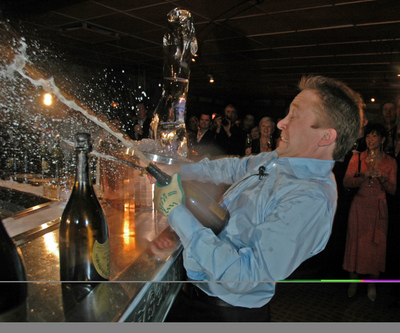
Champagne and Sabres
I am standing in a cellar surrounded by over 20,000 bottles of carefully chosen wine. I have a bottle of Moet et Chandon Imperial in my left hand and a large knife in my right hand.
Slowly I run the blade up and down the neck of the bottle listening to the sound of metal against glass.
Then with a quick flick of the wrist the blade slices off the top of the bottle – cork and glass together – and Moet spurts forth foaming to the floor.
I have sabred my first bottle of champagne.
Andre St. Jacques is the world record holder for sabring, having sabred 21 bottles in under one minute.
He is also the owner of The Bearfoot Bistro in Whistler in Canada. He is happy to teach anyone to sabre. You simply pay for the bottle of champagne, Andre will teach you how to sabre it (no extra charge) and then you have the rest of the evening to enjoy it.
Sabring is a French tradition dating back to the time of Napoleon. The Hussards, under Napoleon’s command, used it as a means of showing off their skill on horseback. They celebrated their victories by ‘sabring’ off the top of a bottle of champagne. As legend has it, these skilled horsemen would ride on horseback at a full gallop while brave (or foolhardy!) ladies would hold up the bottles. With over 100 lbs of pressure per square inch in a bottle of champagne, the sabre must strike the neck at exactly the right angle.
Needless to say, it’s easier when you are standing still and have a world expert at your side to guide you.
It’s worth visiting the Bearfoot Bistro for more than just a lesson in sword play. Their award winning chef Melissa Craig does a wonderful taster menu. You’ll get a number of courses each exquisitely served like a work of art of on a plate. Each course, as the name implies, gives you a taste of a dish, allowing you to try everything on the menu at one sitting!
As each course is served the waiter carefully explains what you are eating, where it has come from and how it has been prepared. There is also a different wine with each course, all from vineyards in British Columbia and all carefully chosen to complement the food. Each is served in a different shape or style of glass. And, like his foodie counterpart, the wine waiter explains each wine, why it has been chosen, which vineyard it came from and perhaps some personal anecdotes about the vintage or the growers.
As a vegetarian my meal looked and tasted as carefully thought through and considered as any of the meat dishes. In no way was I made to feel that somehow my vegetarian status meant I was being given a second rate meal.
There are two desert courses to finish the meal – one served with a maple syrup whiskey and the other with a local ice Wine from Mission Hill. The whiskey is created as a blend of Scotland and Canada celebrating the area’s Scottish ancestry with its Canadian heart.
Like everything at The Bearfoot Bistro it’s a feast for all your senses.
For more information:
The Bearfoot Bistro: http://www.bearfootbistro.com/
About the Author:
Chantal Cooke is an award winning journalist and broadcaster. As well as founding the PASSION for the PLANET group of radio stations, Chantal also writes for a number of national newspapers and magazines.


Pingback: My Homepage
Pingback: Geary Group
Pingback: no approve
Pingback: Goozle Zone